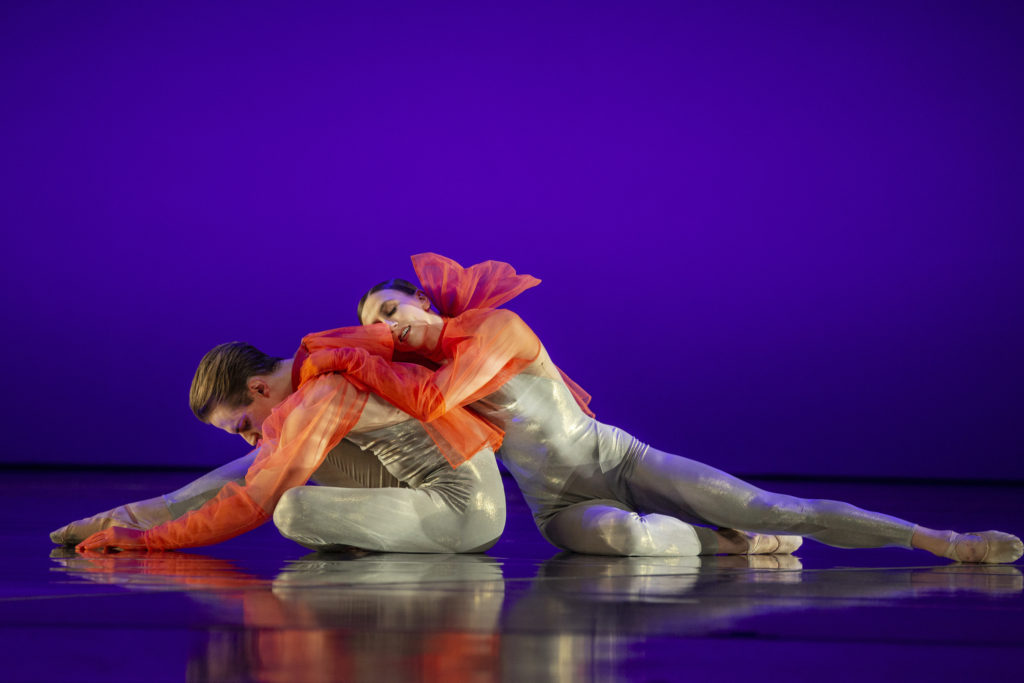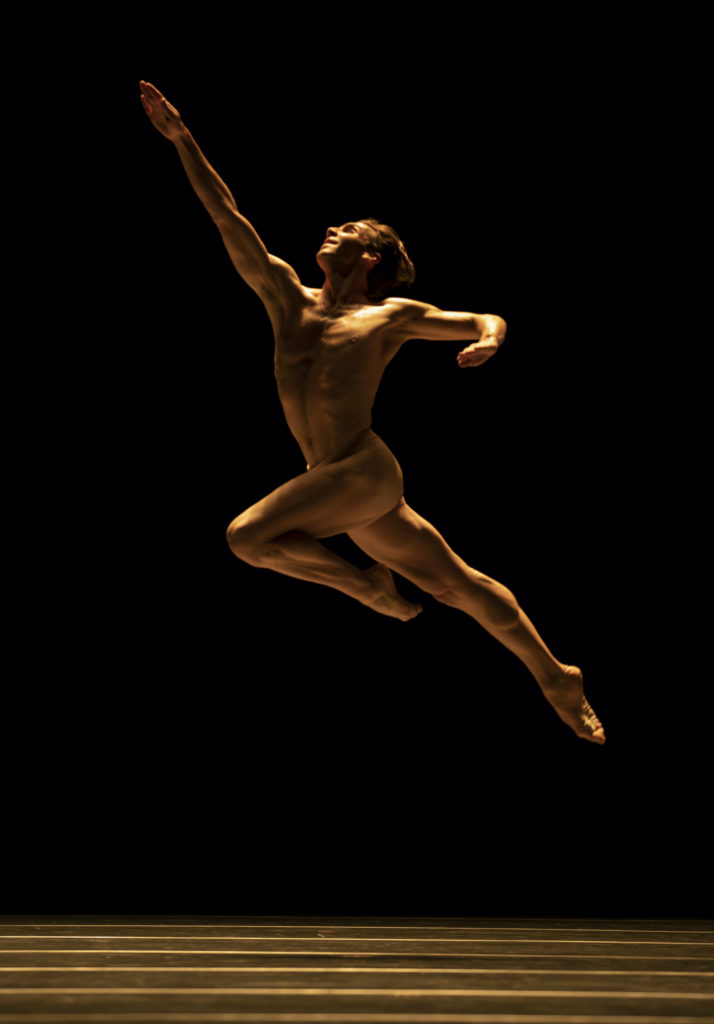World Premieres that Brighten the Digital Stage: Wheeldon and Liang at Pacific Northwest Ballet - Vancouver Ballet Society
- Home
- Reviews 2020 - 2023
- World Premieres that Brighten the Digital Stage: Wheeldon and Liang at Pacific Northwest Ballet

By Tessa Perkins Deneault
The curtain rises to reveal the silhouette of a woman atop a giant full skirt. As the lights come up, the skirt transforms into a huge orange scarf that billows above Jerome Tisserand and his partner Laura Tisserand, who is perched on his shoulders. It’s a beautiful image to punctuate the beginning of Edwaard Liang’s new piece, The Veil Between Worlds, commissioned by Pacific Northwest Ballet and presented as part of their Rep 6 digital program June 10–14.
Liang, based in Columbus, Ohio, where he is Ballet Met’s artistic director, employs larger than life imagery to start the piece, creating the kind of moment that deserves to be seen in person, but even on screen, it’s striking. From Oliver Davis’ hopeful, vibrant music to the beautifully detailed orange, red and blue leotards by Mark Zappone, The Veil Between Worlds is full of joy.
Dylan Wald and Elle Macy join the Tisserands (who are a couple in real life) for a jubilant opening sequence that sets the tone of the whole ballet. Later, the Tisserands share a tender duet, accompanied by plaintive violin and full of smooth slides and lifts, which demonstrates their natural chemistry — a reminder of why they will be missed next season as they leave PNB to join Les Ballets de Monte-Carlo.
The scarf returns a few times as a visual element that dances in its own right and extends the dancers’ lines, while conveying heightened emotion. Wald emerges from under the scarf to perform a captivating, angsty lament that ends with the scarf overtaking him and sweeping him offstage. A radiant duet from Lucien Postlewaite and Leta Biasucci, and a final group sequence full of quick, light jumps, ends the piece on a high note before the scarf has the final movement, making one last tour of the stage.

Curious Kingdom, the opening piece by British-born Christopher Wheeldon — another world premiere — also begins in silhouette. Five dancers stand distanced from each other on a large reflective rectangle, with yellow-hued lighting by Reed Nakayama, who bring his understanding of video design to light the whole piece with style and clarity for the digital stage. Angular movements mirror Maurice Ravel’s slow piano score note for note. The lighting shifts to blue as Postlewaite’s solo introduces more fluidity and emotional resonance to Wheeldon’s choreography, accompanied by Erik Satie’s contemplative Gnossiennes. With the medium in mind, creative camera angles, including overhead shots, take advantage of the reflective stage surface and add new perspectives.
Wald and Macy, each wearing one long orange glove along with their sparkly gold unitards, share a slow, controlled duet that has them combining in variously inventive animal forms. What the section lacks in obvious meaning, it makes up for in creative postmodern forms — a curious kingdom indeed. In another duet for this pair, Wheeldon plays with mirroring and small hand movements, using arms to create frames for heads to pass through, all with great poignancy.
As Wald and Macy rest their heads on each other’s shoulders, the image fades out while another shot of the pair, suddenly wearing gloves and large tulle bows, fades into view. This marks the transition to a series of Edith Piaf songs along with smooth, lyrical movements. Postlewaite’s solo to “Non, je ne regrette rien” is a vulnerable, slow-burning offering to end the piece.

Also on this triple bill is PACOPEPEPLUTO from PNB resident choreographer Alejandro Cerrudo. The series of three solos share a grounded, measured tone, yet there is also a playful sensibility as the dancers spend a lot of time with their backs to the audience and perform flexed-feet jumps and somersaults — not to mention the literal cheekiness of the almost-nude costuming that has them in nothing but dance belts. James Yoichi Moore’s solo to Dean Martin’s “Memories Are Made of This” was technically impressive, but lacked the lightheartedness that seemed called for. That’s where Postlewaite excels in his solo to “That’s Amore” (sung by Joe Scalissi, a Dean Martin impersonator) — even with low stage lighting and his back mostly to the audience, there was an easy expressiveness.
Filmed with multiple camera angles and packaged with bonus content, including an interview with Liang and his short piece Distant Cries, PNB has done an excellent job with this conclusion to their all-digital season.

